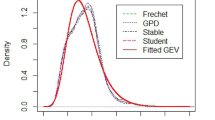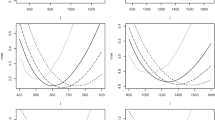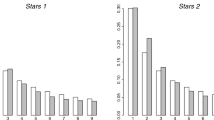Abstract
Many natural phenomena exhibit size distributions that are power laws or power law type distributions. Power laws are specific in the sense that they can exhibit extremely long or heavy tails. The largest event in a sample from such distribution usually dominates the underlying physical or generating process (floods, earthquakes, diamond sizes and values, incomes, insurance). Often, the practitioner is faced with the difficult problem of predicting values far beyond the highest sample value and designing his “system” either to profit from them, or to protect against extreme quantiles. In this paper, we present a novel approach to estimating such heavy tails. The estimation of tail characteristics such as the extreme value index, extreme quantiles, and percentiles (rare events) is shown to depend primarily on the number of extreme data that are used to model the tail. Because only the most extreme data are useful for studying tails, thresholds must be selected above which the data are modeled as power laws. The mean square error (MSE) is used to select such thresholds. A semiparametric bootstrap method is developed to study estimation bias and variance and to derive confidence limits. A simulation study is performed to assess the accuracy of these confidence limits. The overall methodology is applied to the Harvard Central Moment Tensor catalog of global earthquakes.
Similar content being viewed by others
REFERENCES
Agterberg, F. P., Cheng, Q., and Wright, D. F., 1993, Fractal modelling of mineral deposits, in Elbrond and Tang, eds., APCOM93, Can. Inst. Min., Met. and Petr. Engin. (Montreal), p. 43–53.
Bagnold, R. A., 1937, The size grading of sand by wind: Proc. Roy. Soc., v. A163, p. 250–264.
Bagnold, R. A., and Barndorff–Nielsen, O., 1980, The pattern of natural size distributions: Sedimentology, v. 27, p. 199–207.
Beirlant, J., Vynckier, P., and Teugels, J. L., 1996a, Tail index estimation, pareto quantile plots and regression diagnostics: J. Am. Stat. Assoc., v. 91, p. 1659–1667.
Beirlant, J., Vynckier, P., and Teugels, J. L., 1996b, Excess functions and estimation of the extreme value index: Bernoulli, v. 2, p. 293–318.
Beirlant, J., Teugels, J. L., and Vynckier, P., 1996c, Practical analysis of extreme values: Leuven University Press, Leuven.
Bennet, J. G., 1936, Broken coal: J. Inst. Fuel, v. 10, p. 22–39.
Caers, J., 1996. Statistical and geostatistical valuation of diamond deposits: unpubl. Doctoral dissertation, Katholieke Universiteit Leuven, Leuven, 220 p.
Csorgö, S., and Viharos, L., 1998, Estimating the tail index, in Szyszkowicz, B., ed., Asymptotic methods in probability and statistics: Elsevier, Amsterdam.
Danielsson, J., de Haan, Peng, L., and de Vries, C. G., 1997, Using a bootstrap method to choose the sample fraction in the tail index estimation: Report TI97-016 ?4, Erasmus University Amsterdam, Amsterdam.
Dargahi-Noubary, G. R., 1989, On tail estimation: An improved method: Math. Geology, v. 21, p. 829–842.
Dekkers, L. M., Einmahl, J. H. J., and de Haan, L., 1989, A moment-estimator for the index of the extreme value distribution: Ann. Stat., v. 17, p. 1833–1855.
Deutsch, C. V., and Journel, A. G., 1997, GSLIB: Geostatistical software library and user's guide: Oxford University Press, New York, 368 p.
Drew, L. J., Schuenemeyer, J. H., and Bawiec, W. J., 1982, Estimation of future rates of oil and gas discoveries in the Western Gulf of Mexico: U.S. Geol. Survey, Prof. paper 1252.
Dziewonski, A. M., Ekstöm, G., and Salganik, M. P., 1993, Centroid-moment tensor soluation for January–March 1992: Phys. Earth Planet. Inter., v. 77, p. 143–150.
Efron, B., and Tibshirani, R., 1993, An introduction to the bootstrap: Chapman and Hall, New York.
Hall, P., 1982, On simple estimates of an exponent of regular variation: J. Roy. Stat. Soc., B, v. 44, p. 37–42.
Hall, P., 1990, Using the bootstrap to estimate mean squared error and select smoothing parameters in nonparametric problems: J. Multivariate Anal., v. 32, p. 177–203.
Hartmann, 1960, Terrestrial, lunar and interplanetary rock fragmentation: Icarus, v. 10, p. 201–322.
Hill, B. M., 1975, A simple and general approach to inference about the tail of a distribution: Ann. Stat., v. 3, p. 1163–1174.
Houghton, J. C., 1988, Use of the truncated shifted pareto distribution in assessing size distribution of oil and gas fields: Math. Geology, v. 20, p. 907–937.
Krige, D. G., and Dohm, C. E., 1994, The role of massive grade data bases in geostatistical applications in South African gold mines, in Dimitrakopoulos, R., ed., Geostatistics for the next century, Kluwer, Dordrecht, p. 46–54.
Mandelbrot, B. B., 1982, The fractal geometry of nature: Freeman, San Francisco.
McCrosky, R. E., 1968, Distribution of large meteorite bodies: Smithson. Astrophys. Observ., Washington, D.C., Spec. Rep. 280.
Pickands, J., 1975, Statistical inference using extreme order statistics: Ann. Stat., v. 3, p. 119–131.
Rombouts, L., 1991, Statistical distributions for diamonds, in Meyer, H. O. A. and Leonardos, O. H., eds., Proceedings of the fifth international kimberlite conference, Araxa (Brasil): CPRM, Spec. Publ., 1B?/93, p. 202–214.
Schoutens, J. E., 1979, Empirical analysis of nuclear and high explosive cratering and analysis: Nuclear geoplosics, v. 55, Rep. DNA OIH-42.
Seyedghasemipour, S. J., and Bhattacharyya, B. B., 1990, The loghyperbolic: An alternative to the lognormal for modeling oil field size distribution: Math. Geology, v. 22, p. 557–571.
Sichel, H. S., Kleingeld, W. J., and Assibey-Bonsu, W. A., 1992, A comparative study of three frequency-distribution models for use in ore evaluation: J. South Afr. Inst. Min. Metall., v. 92, p. 235–243.
Smith, R. L., 1987, Estimating tails of probability distributions: Ann. Stat., v. 15, p. 1174–1207.
Sornette, D., Knopoff, L., Kagan, Y. Y., and Vanneste, C., 1996, Rank-ordering statistics of extreme events: Application to the distribution of large earthquakes: J. Geophys. Res., v. 101, p. 13883–13893.
Turcotte, D. L., 1997, Fractals and chaos in geology and geophysics: Cambridge University Press.
Author information
Authors and Affiliations
Rights and permissions
About this article
Cite this article
Caers, J., Beirlant, J. & Maes, M.A. Statistics for Modeling Heavy Tailed Distributions in Geology: Part I. Methodology. Mathematical Geology 31, 391–410 (1999). https://doi.org/10.1023/A:1007538624271
Issue Date:
DOI: https://doi.org/10.1023/A:1007538624271




